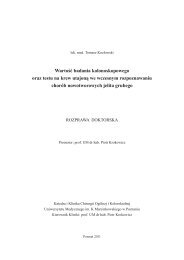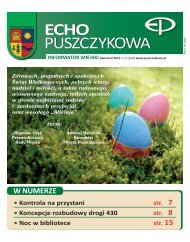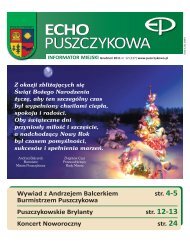MILITARY PHARMACY AND MEDICINE
MILITARY PHARMACY AND MEDICINE
MILITARY PHARMACY AND MEDICINE
Create successful ePaper yourself
Turn your PDF publications into a flip-book with our unique Google optimized e-Paper software.
© Military Pharmacy and Medicine • 2012 • 4 • 11 – 16pigments and PUFA-ω3 in AMD patients. Itshould be mentioned that the AREDS study is amulticenter, 5-year clinical study conducted inmore than 3,000 patients. The objective of thestudy was to assess the effect of high doses ofantioxidants (these included vitamin C, vitaminE and β-carotene) and zinc on the progression ofAMD. As shown by the published reports, thetested AREDS formula did not inhibit vision loss,although it had some beneficial effects reducingthe risk of further development of AMD. Authorsof the promising article titled “New approachesand potential treatments for dry age-related maculardegeneration”, published in 2012, make referenceto the AREDS study reports of 2001 andthe Erratum of 2008 — report as follows: “theAREDS formula does not prevent GA [geographicatrophy] from forming or progressing” [40].AREDS-2 (ClinicalTrials.gov; Identifier NTC00345176; sponsored by National Eye Institute(NEI) with collaboration from National Heart,Lung, and Blood Institute – NHLBI), is, similarlyto AREDS, a 5-to-6-year (2007–December 2012),multicenter (82 clinical centers in the UnitedStates), randomized clinical study to evaluate theeffect of oral supplementation with macular xanthophylls(lutein, zeaxanthin) and omega-3 polyunsaturatedacids (PUFA-ω3) (DHA, EPA) onAMD progression. Below is the list of agents testedin AREDS (AREDS-1) and AREDS-2 studies:Jerzy Z. Nowak: Age-related macular degeneration (AMD): a critical appraisal …retinoids may act as substrates for formation ofphotocytotoxic bis-retinoids. Beneficial effectsof zinc have been known for a long time, andthere was no need for another detailed verificationof its advantages. However, a question arosewith regard to the dose — it would be better if thelower dose (25, not 80 mg) was efficient. As far asthe PUFA-ω3 doses used in AREDS-2 study areconcerned, the author agrees with the total doseof 1 g, although he is not certain whether 650 mgof EPA and 350 of DHA is a good dose ratio (1.86)for AMD patients. Considering the role of DHAin the photoreceptors–RPE cells complex [3], onemight expect a higher dose of DHA (possibly atthe cost of a lower amount of EPA).Combination preparations (“all in one”: macularpigments, microelements, PUFA-ω3) may beconvenient for patients; however, the manufacturersare well aware that the presence of reasonableamounts of PUFA-ω3 in capsules requiresenlarged capsule size, which is not always associatedwith greater convenience of use. One gramof PUFA-ω3 (as used in AREDS-2) takes up aconsiderable volume, thus a “combination” capsulecontaining such an amount should be appropriatelylarge. When trying to adhere to the trendof administering one capsule of a dietary supplementper day, the capsule should contain “daily”doses of all ingredients which would obviously betranslated into capsule size.AREDS-1: vitamin C — 500 mg, vitamin E — 400IU, beta-carotene — 15 mg, zinc (as zinc oxide) — 25and 80 mg, copper (as cupric oxide) — 2 mg;AREDS-2: lutein — 10 mg, zeaxanthin — 2 mg, vitaminC — 500 mg, vitamin E — 400 IU, copper (as cupricoxide) — 2 mg, EPA – 650 mg, DHA – 350 mg.Smaller studies (Secondary RandomizationAgents — AREDS-Type Supplement) were alsoconducted to examine the effects of zinc (aszinc oxide) at doses of 25 and 80 mg, with particularfocus on the lower dose, and eliminationof β-carotene form the AREDS formula.Of note is the lack of beta-carotene and zinc inthe Primary Randomization Agents of AREDS-2study. As shown by the alpha-tocopherol, betacarotenecancer prevention study (ATBC), betacarotenecontributes to the development of lungcancer in smokers [41]; in addition, beta-caroteneis a precursor of vitamin A, and the visual cyclehttp://military.isl-journals.comHowever, there is one argument that does notsupport combining PUFA-ω3 with the remainingingredients in preparations recommended toAMD patients. AMD patients are usually at anadvanced age, and PUFA-ω3 are often recommendedto them also by physicians of other (nonophthalmological)specializations. For example,cardiologists and psychiatrists (as well as otherphysicians, although these two specializationsare predominant) nearly routinely recommendPUFA-ω3-rich dietary supplements at daily dosesthat often exceed 1 g. Facing different trade namesof various “cardiologic”, “psychiatric” and “ophthalmic”dietary supplements, patients may beunaware that they actually take the same chemicalentities! And all these entities are accumulated inthe same system! Therefore, it might happen thata patient would take not 1, but 2, and perhaps 3or more grams of PUFA-ω3 per day while beingunaware of this fact! Taking such scenario intoconsideration, one should not forget preparations11
















